新概念语法题总结
- 格式:doc
- 大小:56.00 KB
- 文档页数:7
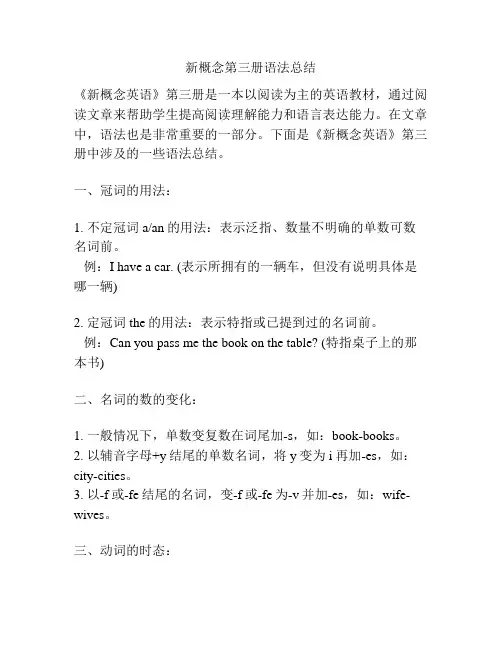
新概念第三册语法总结《新概念英语》第三册是一本以阅读为主的英语教材,通过阅读文章来帮助学生提高阅读理解能力和语言表达能力。
在文章中,语法也是非常重要的一部分。
下面是《新概念英语》第三册中涉及的一些语法总结。
一、冠词的用法:1. 不定冠词a/an的用法:表示泛指、数量不明确的单数可数名词前。
例:I have a car. (表示所拥有的一辆车,但没有说明具体是哪一辆)2. 定冠词the的用法:表示特指或已提到过的名词前。
例:Can you pass me the book on the table? (特指桌子上的那本书)二、名词的数的变化:1. 一般情况下,单数变复数在词尾加-s,如:book-books。
2. 以辅音字母+y结尾的单数名词,将y变为i再加-es,如:city-cities。
3. 以-f或-fe结尾的名词,变-f或-fe为-v并加-es,如:wife-wives。
三、动词的时态:1. 一般现在时:表示习惯性、经常性或客观真理等。
例:Water boils at 100 degrees Celsius. (客观真理)2. 一般过去时:表示过去发生或存在的动作或状态。
例:She lived in London for five years. (过去发生的动作)3. 现在进行时:表示现在正在进行的动作。
例:I am reading a book now. (正在进行的动作)4. 过去进行时:表示过去某一时间正在进行的动作。
例:He was studying when I called him. (过去某一时间正在进行的动作)5. 一般将来时:表示将来某一时间将要发生的动作。
例:I will go to the cinema tomorrow. (将来某一时间将要发生的动作)四、形容词和副词的比较等级:1. 一般形容词比较等级:例:good - better - best (好 - 更好 - 最好)2. 以-y结尾的形容词,变-y为-i,再加-er或-est:例:happy - happier - happiest (快乐 - 更快乐 - 最快乐)五、连词的用法:1. 并列连词and:用于连接并列的词、短语、从句等。
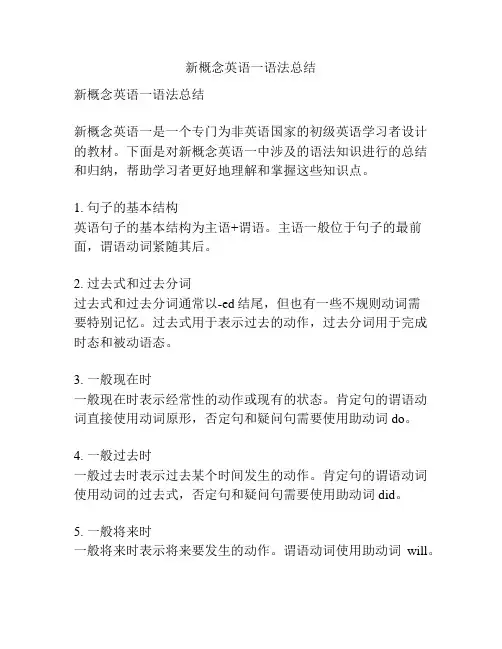
新概念英语一语法总结新概念英语一语法总结新概念英语一是一个专门为非英语国家的初级英语学习者设计的教材。
下面是对新概念英语一中涉及的语法知识进行的总结和归纳,帮助学习者更好地理解和掌握这些知识点。
1. 句子的基本结构英语句子的基本结构为主语+谓语。
主语一般位于句子的最前面,谓语动词紧随其后。
2. 过去式和过去分词过去式和过去分词通常以-ed结尾,但也有一些不规则动词需要特别记忆。
过去式用于表示过去的动作,过去分词用于完成时态和被动语态。
3. 一般现在时一般现在时表示经常性的动作或现有的状态。
肯定句的谓语动词直接使用动词原形,否定句和疑问句需要使用助动词do。
4. 一般过去时一般过去时表示过去某个时间发生的动作。
肯定句的谓语动词使用动词的过去式,否定句和疑问句需要使用助动词did。
5. 一般将来时一般将来时表示将来要发生的动作。
谓语动词使用助动词will。
6. 现在进行时现在进行时表示现在正在进行的动作。
谓语动词由be动词(am、is、are)+动词的现在分词构成。
7. 一般将来时(be going to)一般将来时还可以用be going to来表示。
肯定句的谓语动词由am、is、are + going to + 动词原形构成。
8. 现在完成时现在完成时表示过去发生并与现在有关的动作。
谓语动词由have/has + 动词的过去分词构成。
9. 进行时态进行时态表示现在(或将来)某一时刻正在进行的动作。
谓语动词由助动词be的适当形式 + 动词的现在分词构成。
10. 完成时态完成时态表示过去某一时刻已完成的动作。
谓语动词由助动词have的适当形式 + 动词的过去分词构成。
11. 被动语态被动语态表示主语是动作的承受者。
谓语动词由be的适当形式 + 动词的过去分词构成。
12. 情态动词情态动词表示可能性、能力、意愿、许可等。
常用的情态动词有can、could、may、might、must、shall、should、will、would等。

新概念英语语法总结一.时态:一般现在时,现在进行时,一般过去时,现在完成时,一般将来时,过去进行时,过去完成时,过去将来时1. 一般现在时表示一般性,经常性的动作或一般性事实。
u 含有be动词的句子He is a teacher.The girl is very beautiful.Tim and Jack are students.★变疑问句将be动词移到句首Is he a teacher?Is the girl very beautiful?Are Tim and Jack students?★变否定句在be动词后面加notHe is not a teacher.The girl is not very beautiful.Tim and Jack are not students.★肯定回答及否定回答Yes, he is. No, he is not.Yes, she is. No, she is not.Yes, they are. No, they are not.u 不含有动词的句子,即含有一般动词的句子第三人称单数及单数名词He likes books.She likes him.The dog likes bones.★变疑问句在句首加does, 动词变为原型Does he like books?Does she like him?Does the dog like bones?★变否定句在主语及动词之间加doesn’t, 动词变为原型He doesn’t like books.She doesn’t like him.The dog doesn’t like bones.★肯定回答及否定回答:Yes, he does. No, he doesn’t.Yes, she does. No, she doesn’tYes, it does. No, it doesn’t.注意:第三人称单数形式一般在动词后面加S,不要和名词复数混淆,变否定句或疑问句时名词复数没有任何变化。

新概念前100课时态语法总结一般现在时A:一般现在时结构:1)be动词的第一人称单数为,第三人称单数为,其他人称为。
有一顺口溜体现了它的用法:我用am ,你用are ,is 用于他,她,它, 单数is,复数are.肯定式:主语+ am /is/are +其他否定式:主语+ am/is/are +not + 其他疑问式:Am /Is /Are + 主语+ 其他?简略回答: (肯) Yes,主语+ am/ is /are(否) No,主语+ am /is/are not缩写形式: I'm that's we'rewhat's they're isn'tyou're who's where's he'sshe's it's aren't2)行为动词(实义动词)除主语是第三人称单数外,都用动词原形,主语是第三人称单数时,在动词词尾加-s或-es 。
肯定式:主语+动词原形/动词的第三人称单数否定式:主语+助动词don't/doesn't +动词原形+其他疑问式:Do/Does+主语+动词原形+其他简略回答:(肯)Yes,主语+do/does (否)No,主语+do/does not缩写形式: don't doesn't注意:“动词第三人称单数”的加法即“如何从动词原形变为第三人称单数”1、一般情况加s.2、以o, s, x, ch, sh 结尾加es.3、以“辅音字母+y”结尾,改y为i +es练习一写出下列动词的第三人称单数:study play go comehelp teach lie listenbegin open sit washguess eat run relaxB一般现在时用法经常性或习惯性的动作,常与表示频度的时间状语连用。
时间状语:always, usually, often, frequently, sometimes, hardly, never, every day (week, year, month/), once a week, on Sundays, etc.现在进行时现在进行时表示目前或目前阶段正在进行的动作。
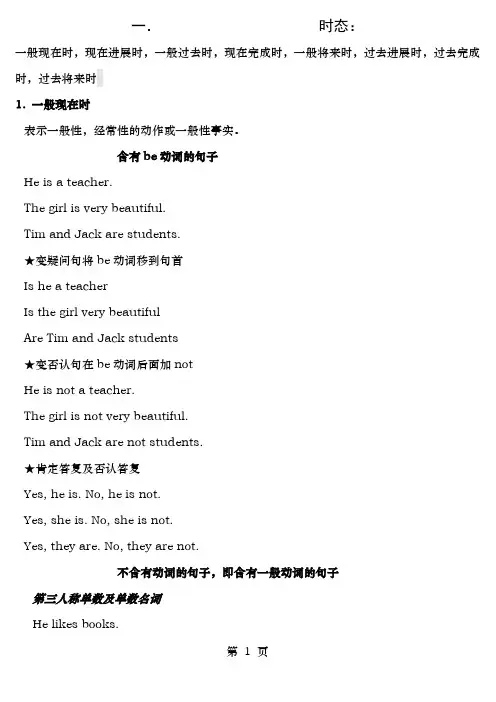
一.时态:一般现在时,现在进展时,一般过去时,现在完成时,一般将来时,过去进展时,过去完成时,过去将来时1. 一般现在时表示一般性,经常性的动作或一般性事实。
含有be动词的句子He is a teacher.The girl is very beautiful.Tim and Jack are students.★变疑问句将be动词移到句首Is he a teacherIs the girl very beautifulAre Tim and Jack students★变否认句在be动词后面加notHe is not a teacher.The girl is not very beautiful.Tim and Jack are not students.★肯定答复及否认答复Yes, he is. No, he is not.Yes, she is. No, she is not.Yes, they are. No, they are not.不含有动词的句子,即含有一般动词的句子第三人称单数及单数名词He likes books.She likes him.The dog likes bones.★变疑问句在句首加does, 动词变为原型Does he like booksDoes she like himDoes the dog like bones★变否认句在主语及动词之间加doesn’t, 动词变为原型He doesn’t like books.She doesn’t like him.The dog doesn’t like bones.★肯定答复及否认答复:Yes, he does. No, he doesn’t.Yes, she does. No, she doesn’tYes, it does. No, it doesn’t.注意:第三人称单数形式一般在动词后面加S,不要与名词复数混淆,变否认句或疑问句时名词复数没有任何变化。
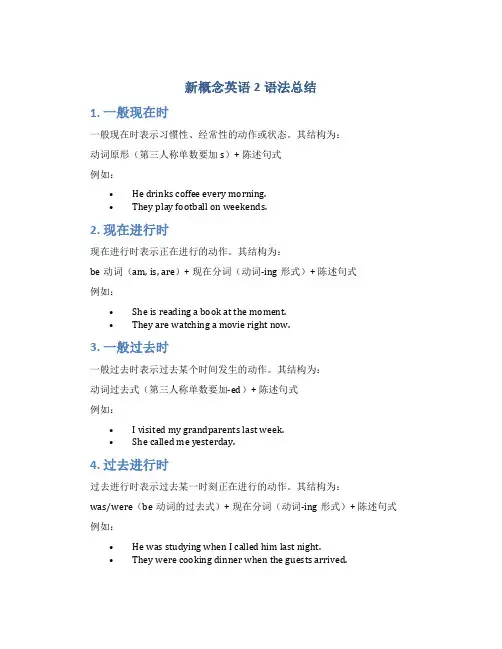
新概念英语2语法总结1. 一般现在时一般现在时表示习惯性、经常性的动作或状态。
其结构为:动词原形(第三人称单数要加s)+ 陈述句式例如:•He drinks coffee every morning.•They play football on weekends.2. 现在进行时现在进行时表示正在进行的动作。
其结构为:be动词(am, is, are)+ 现在分词(动词-ing形式)+ 陈述句式例如:•She is reading a book at the moment.•They are watching a movie right now.3. 一般过去时一般过去时表示过去某个时间发生的动作。
其结构为:动词过去式(第三人称单数要加-ed)+ 陈述句式例如:•I visited my grandparents last week.•She called me yesterday.4. 过去进行时过去进行时表示过去某一时刻正在进行的动作。
其结构为:was/were(be动词的过去式)+ 现在分词(动词-ing形式)+ 陈述句式例如:•He was studying when I called him last night.•They were cooking dinner when the guests arrived.5. 一般将来时一般将来时表示将来某个时间会发生的动作或状态。
其结构为:will/shall(情态动词)+ 动词原形 + 陈述句式例如:•I will visit my friend next week.•He will cook dinner tonight.6. 现在完成时现在完成时表示过去某个时间范围内发生的动作,且与现在有关。
其结构为:have/has(情态动词)+ 过去分词(动词的第三态)+ 陈述句式例如:•She has finished her homework.•They have watched that movie.7. 过去完成时过去完成时表示过去某个时间点之前已经发生的动作或状态。
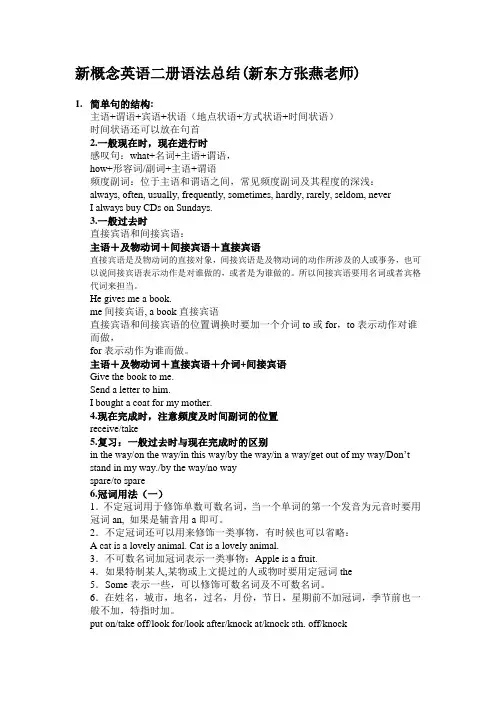
新概念英语二册语法总结(新东方张燕老师)1.简单句的结构:主语+谓语+宾语+状语(地点状语+方式状语+时间状语)时间状语还可以放在句首2.一般现在时,现在进行时感叹句:what+名词+主语+谓语,how+形容词/副词+主语+谓语频度副词:位于主语和谓语之间,常见频度副词及其程度的深浅:always, often, usually, frequently, sometimes, hardly, rarely, seldom, neverI always buy CDs on Sundays.3.一般过去时直接宾语和间接宾语:主语+及物动词+间接宾语+直接宾语直接宾语是及物动词的直接对象,间接宾语是及物动词的动作所涉及的人或事务,也可以说间接宾语表示动作是对谁做的,或者是为谁做的。
所以间接宾语要用名词或者宾格代词来担当。
He gives me a book.me间接宾语, a book直接宾语直接宾语和间接宾语的位置调换时要加一个介词to或for,to表示动作对谁而做,for表示动作为谁而做。
主语+及物动词+直接宾语+介词+间接宾语Give the book to me.Send a letter to him.I bought a coat for my mother.4.现在完成时,注意频度及时间副词的位置receive/take5.复习:一般过去时与现在完成时的区别in the way/on the way/in this way/by the way/in a way/get out of my way/Don’t stand in my way./by the way/no wayspare/to spare6.冠词用法(一)1.不定冠词用于修饰单数可数名词,当一个单词的第一个发音为元音时要用冠词an, 如果是辅音用a即可。
2.不定冠词还可以用来修饰一类事物,有时候也可以省略:A cat is a lovely animal. Cat is a lovely animal.3.不可数名词加冠词表示一类事物:Apple is a fruit.4.如果特制某人,某物或上文提过的人或物时要用定冠词the5.Some表示一些,可以修饰可数名词及不可数名词。
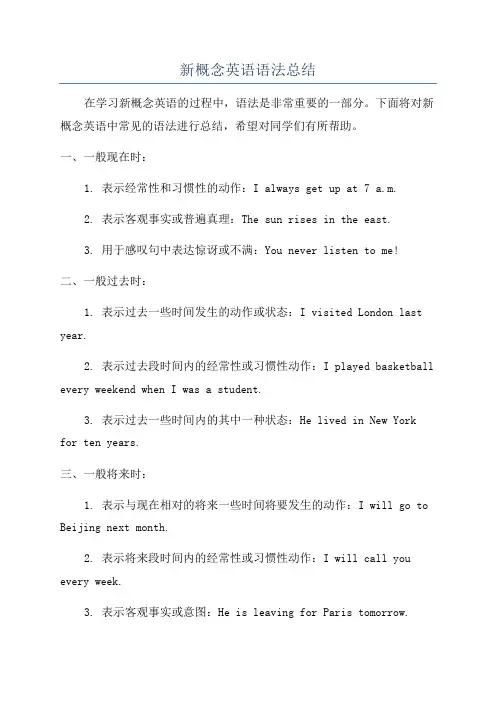
新概念英语语法总结在学习新概念英语的过程中,语法是非常重要的一部分。
下面将对新概念英语中常见的语法进行总结,希望对同学们有所帮助。
一、一般现在时:1. 表示经常性和习惯性的动作:I always get up at 7 a.m.2. 表示客观事实或普遍真理:The sun rises in the east.3. 用于感叹句中表达惊讶或不满:You never listen to me!二、一般过去时:1. 表示过去一些时间发生的动作或状态:I visited London last year.2. 表示过去段时间内的经常性或习惯性动作:I played basketball every weekend when I was a student.3. 表示过去一些时间内的其中一种状态:He lived in New Yorkfor ten years.三、一般将来时:1. 表示与现在相对的将来一些时间将要发生的动作:I will go to Beijing next month.2. 表示将来段时间内的经常性或习惯性动作:I will call you every week.3. 表示客观事实或意图:He is leaving for Paris tomorrow.四、现在进行时:1. 表示说话时正在发生的动作:I am reading a book now.2. 表示当前周围的事物或事正在发生:It is raining outside.五、过去进行时:1. 表示过去时刻正在发生的动作:I was watching TV at 9 p.m. yesterday.2. 表示过去段时间内一直在进行的动作:I was studying for the exam all night.六、将来进行时:1. 表示将来一些时间正在进行的动作:I will be working at 3 p.m. tomorrow.2. 表示将来段时间内一直在进行的动作:I will be studying for the exam all night.七、一般过去完成时和过去完成进行时:1. 表示在过去一些时间之前已经完成的动作:He had finished the project when I arrived.2. 表示在过去一些时间之前一直在进行的动作:I had been waiting for an hour when the bus finally arrived.八、一般将来完成时和将来完成进行时:1. 表示在将来一些时间点之前将会完成的动作:I will have finished the report by the end of this week.九、情态动词:1. can:表示能力或许可性,可以用于一般现在时、一般过去时和一般将来时。
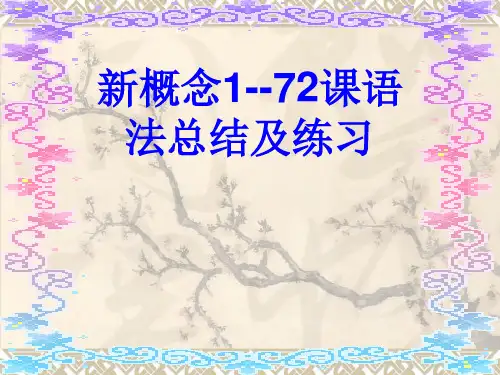
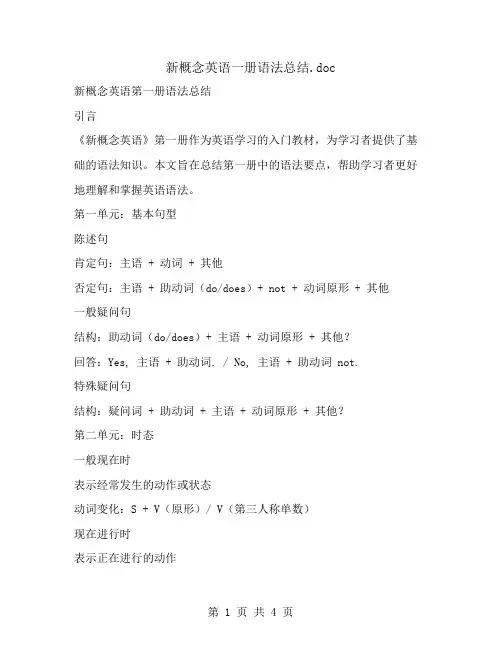
新概念英语一册语法总结.doc新概念英语第一册语法总结引言《新概念英语》第一册作为英语学习的入门教材,为学习者提供了基础的语法知识。
本文旨在总结第一册中的语法要点,帮助学习者更好地理解和掌握英语语法。
第一单元:基本句型陈述句肯定句:主语 + 动词 + 其他否定句:主语 + 助动词(do/does)+ not + 动词原形 + 其他一般疑问句结构:助动词(do/does)+ 主语 + 动词原形 + 其他?回答:Yes, 主语 + 助动词. / No, 主语 + 助动词 not.特殊疑问句结构:疑问词 + 助动词 + 主语 + 动词原形 + 其他?第二单元:时态一般现在时表示经常发生的动作或状态动词变化:S + V(原形)/ V(第三人称单数)现在进行时表示正在进行的动作结构:S + am/is/are + V-ing一般过去时表示过去发生的动作或状态结构:S + V-ed(规则动词)/ 特殊形式(不规则动词)现在完成时表示过去发生的动作对现在有影响或结果结构:S + have/has + V-ed第三单元:名词可数名词规则复数:名词 + -s或-es不规则复数:特殊形式不可数名词通常没有复数形式名词所有格表示所有关系:名词's 或 of 结构第四单元:代词人称代词主格:I, you, he, she, it, we, they宾格:me, you, him, her, it, us, them物主代词形容词性物主代词:my, your, his, her, its, our, their名词性物主代词:mine, yours, his, hers, its, ours, theirs 反身代词myself, yourself, himself, herself, itself, ourselves, themselves第五单元:形容词和副词形容词描述名词的性质或特征副词描述动词、形容词或其他副词比较级和最高级规则形式:比较级 -er, 最高级 -est不规则形式:特殊形式第六单元:介词时间介词in, on, at地点介词in, on, at, above, below, beside, behind, in front of方式介词by, with, through第七单元:连词并列连词and, but, or, yet, for, nor, so从属连词that, if, whether, who, what, where, when, how第八单元:冠词不定冠词a, an定冠词the零冠词在某些情况下可以省略冠词结论《新概念英语》第一册为英语学习者提供了扎实的语法基础。
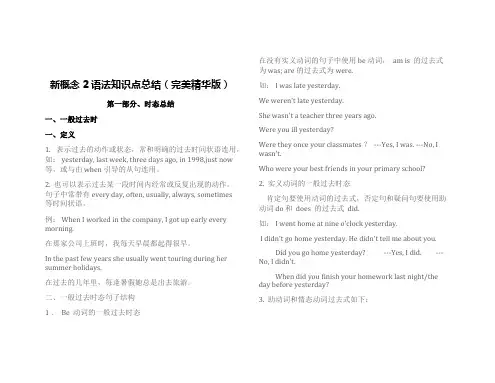
新概念2语法知识点总结(完美精华版)第一部分、时态总结一、一般过去时一、定义1. 表示过去的动作或状态,常和明确的过去时间状语连用,如: yesterday, last week, three days ago, in 1998,just now 等,或与由 when 引导的从句连用。
2. 也可以表示过去某一段时间内经常或反复出现的动作。
句子中常带有 every day, often, usually, always, sometimes等时间状语。
例: When I worked in the company, I got up early every morning.在那家公司上班时,我每天早晨都起得很早。
In the past few years she usually went touring during her summer holidays.在过去的几年里,每逢暑假她总是出去旅游。
二、一般过去时态句子结构1 . Be 动词的一般过去时态在没有实义动词的句子中使用 be 动词, am is 的过去式为 was; are 的过去式为 were.如: I was late yesterday.We weren't late yesterday.She wasn't a teacher three years ago.Were you ill yesterday?Were they once your classmates ? ---Yes, I was. ---No, I wasn't.Who were your best friends in your primary school?2. 实义动词的一般过去时态肯定句要使用动词的过去式,否定句和疑问句要使用助动词 do 和 does 的过去式 did.如: I went home at nine o'clock yesterday.I didn't go home yesterday. He didn't tell me about you.Did you go home yesterday? ---Yes, I did. ---No, I didn't.When did you finish your homework last night/the day before yesterday?3. 助动词和情态动词过去式如下:shall ― should (将要)用于第一人称单数will ― would (将要)用于所有人称can ― could (能,会)may ― might (可以)must ― must (必须) have to ― had to (不得不)助动词和情态动词的过去时态要使用他们的过去式,后面的动词还使用原形。
新概念英语第二册语法解析及练习题新概念英语第二册语法解析及练习题:过去将来进行时过去将来进行时:should / would be + 现在分词表示从过去的某个时间到未来的某个时间正在进行的动作。
. He asked me what I should be doing when he came the next day.练习:1. Tomorrow, I ________ the book all morning.A. am readingB. will be readingC. will readD. have read2. -"Can you attend the meeting tonight?" -"No,________ the manager aboutsomething urgent."A. I seeB. I'll have seenC. I'll be seeingD. I can see3. Of the millions who saw Haley's et in 1986, how many people ________long enough to see it return in the twenty-first century?A. will they liveB. they will be livingC. will liveD. living4. He told us that he ________ visiting Japan by this time next year.A. will beB. would beC. wasD. is5. It ________ when you wake up tomorrow morning.A. is snowingB. will snowC. will be snowingD. snows答案:1. B2. C3. C4. B5. C新概念英语第二册语法解析及练习题:过去完成进行时过去完成进行时:had been + 现在分词表示一直持续到过去某个时间的动作。
新概念二语法要点总结
1. 一般现在时
- 表示经常发生的动作或永久性的事实
- 使用的情况:现实中的事实,普遍真理,惯和日常活动
- 结构:主语 + 动词原形(第三人称单数加 -s)
2. 一般过去时
- 表示过去发生的动作或状态
- 使用的情况:过去发生的动作或状态,与现在无关的过去动作
- 结构:主语 + 动词过去式
3. 现在进行时
- 表示现在正在进行的动作
- 使用的情况:当前正在进行或发生的动作
- 结构:主语 + be(am/is/are)+ 现在分词(动词+ing)
4. 过去进行时
- 表示过去某个时间正在进行的动作
- 使用的情况:过去某个时间正在进行的动作
- 结构:主语 + was/were + 现在分词(动词+ing)
5. 一般将来时
- 表示将来的动作或状态
- 使用的情况:将来要发生的动作或状态
- 结构:主语 + will + 动词原形
6. 过去将来时
- 表示过去将来的动作或状态
- 使用的情况:过去某个时间将要发生的动作或状态
- 结构:主语 + would + 动词原形
7. 现在完成时
- 表示过去完成的动作对现在产生的结果
- 使用的情况:过去发生的动作对现在产生的影响或结果- 结构:主语 + have/has + 过去分词
8. 过去完成时
- 表示过去某一时间之前已经完成的动作
- 使用的情况:过去某一时间之前已经完成的动作
- 结构:主语 + had + 过去分词
以上是新概念二中常用的语法要点总结,能够帮助大家更好地掌握英语语法知识。
英语新概念第一册语法总结《英语新概念第一册》是教授英语的经典教材,在学习英语语法方面也有很多总结和要点。
下面我将对该教材中的语法知识进行总结,以便更好地理解和掌握。
一、基本句型在《英语新概念第一册》中,我们学习了以下基本句型:1. 主语 + 系动词 + 表语例如:This is a book.(这是一本书。
)2. 主语 + 及物动词 + 宾语例如:I like coffee.(我喜欢咖啡。
)3. 主语 + 及物动词 + 间接宾语 + 直接宾语例如:He gave me a present.(他给了我一份礼物。
)4. 主语 + 及物动词 + 宾语 + 宾补例如:We elected him monitor.(我们选举他为班长。
)二、一般现在时及其否定句和疑问句一般现在时表示经常性的动作或者客观事实。
结构为“主语 + 动词原形”,例如:I like swimming.(我喜欢游泳。
)其否定句结构为“主语 + do not/does not + 动词原形”,例如:He does not like apples.(他不喜欢苹果。
)其疑问句结构为“Do/Does + 主语 + 动词原形”,例如:Do you like coffee?(你喜欢咖啡吗?)三、一般过去时及其否定句和疑问句一般过去时表示过去发生的动作或者状态。
结构为“主语 + 动词过去式”,例如:She watched a movie yesterday.(她昨天看了一场电影。
)其否定句结构为“主语 + did not + 动词原形”,例如:We didnot go to school yesterday.(我们昨天没有上学。
)其疑问句结构为“Did + 主语 + 动词原形”,例如:Did you see him?(你看见他了吗?)四、现在进行时及其否定句和疑问句现在进行时表示现在正在进行的动作。
结构为“主语 + be动词(am/is/are)+ 动词现在分词”,例如:They are playing basketball.(他们正在打篮球。
新概念英语语法总复习分数I. 单项选择(50)1. My glasses __b___ on the table a moment ago.a. isb. werec. wasd. are2. There was a football match _a___ the Red Team and the Blue Team.a. betweenb. withc. againstd. at3. My father __b__ in Beijing ____ July 5th last year.a. is; onb. was; onc. is; ind. was in4. –What __b___ is it today? ---It’s Wednesday.a. dateb. dayc. timed. weather5. Tom is ill, so he is absent __b___ school today.a. inb. fromc. withd. in6. Mrs. Brown came to China __d___ 1996.a. fromb. ofc. ond. in7. --- __c___ did you buy the new bag?--- Last Monday.a. Whereb. Howc. Whend. Who8. I like fish, __d___ my brother doesn’t like it.a. sob. orc. ford. but9. My family are going to spend __c__ a week in ____ country.a. /; /b. for; thec. /; thed. / ;a10. --- What are the girls doing? -- They’re __a___ the music.a. listening tob. talking withc. coming fromd. looking for11. I _c__ the children in the garden just now.a. seeb. sawc. have seend. had seen12. How many novels __d__ since last year?a. do you readb. did you readc. have you readd. had you read13. Mrs. Sawyer lives in London. She _a___ since 1990s.a. has come thereb. has came therec. has been thered. has gone there14. Have you __a__ read the story about George Washington?a. everb. neverc. evend. once15. I’ve studied in this school _a___.a. since three years c. before three yearsc. since three years aged. for three years ago16. I wrote a letter to her several weeks ago, but I _d__ it in my pocket all these days.a. keepb. keptc. have keepingd. have kept17. The snow stopped five minutes _a___.a. agob. beforec. afterd. since18. The teacher __c__ you in the classroom.a. waits forb. wait forc. is waiting ford. waited for19. Is this the first time you __d__ Beijing?a. visitb. visitedc. have visitedd. have been visiting20. His grandpa__d_ for two years.a. diesb. has diedc. was deadd. has been dead21. ---Do you have to leave now? ---sorry, but I really_d__.a. can’tb. mustc. haved. should22. Y ou _a___ return the book now. Y ou can keep it till next week if you like.a. can’tb. mustn’tc. needn’td. may not23. --Could I borrow your dictionary? ---yes. Of course you c___.a.. mightb. willc. cand. should24. Jenny, you _b__ play with the knife. Y ou ____ hurt yourself.a. won’t; can’tb. mustn’t; mayc. shouldn’t; mustd. can’t; shoul dn’t25. We _a___ a meeting these days.a. haveb. hadc. are havingd. were having26. The oldest kind of computer _c__ the abacus.a. isb. wasc. has beend. have been27. I _c__ the boy in the classroom just now.a. seeb. sawc. have seend. have been28. ----May I seen Mr. Sawyer? – Can you wait __a__ 3 p. m. ?a. tob. forc. tilld. until29. I need to go shopping today. I haven’t got many potatoes __a___ cabbages.a. orb. butc. andd. /30. We _c__ for Tom at ten last Sunday. He often kept us _____.a. were waiting; waitingb. were waiting; waitC. waited; waiting d. waited; wait31. The day after tomorrow _a___ my brother’s birthday.a. will beb. should bec. may bed. is going to be32. Mrs. Hang isn’t in. she _a___ at home in an hour.a. will beb. will isc. isd. was33. He _a___ in his garden every morning next year.a. will workb. worksc. workedd. is working34. John _d__the Amy at the end of 2000. he ____ in the army since then.a. joined; isb. has joined; has beenc. had joined; isd. joined; has been35. __b__ you _____ the newspaper yet? Y es, I ___ it an hour ago.a. Did; read; didb. Have; read; havec. Have; read; d idd. Did; read; had36. Peter _d___ the work in a week.a. have finishedb. finishesc. is finishingd. will finish37. John __c___ come to see us tomorrow, but he isn’t very sure.a. canb. has toc. mayd. must38. Y ou __b____ go and see the doctor at once because you’re got a fever.a. canb. mustc. dared. would39. ---Shall I tell Mary about it?---No, you _d___ I’ve told her already.a. needn’tb. wouldn’tc. mustn’td. shouldn’t40. ---Will you stay for lunch?---Sorry, I __d___ . my brother will come to see me.a. mustn’tb. can’tc. needn’td. won’t41. John __c___ to Australia only once. He _____ there the year before last.a. has gone; goneb. has gone; wentc. has been; goned. has been; went42. ---Could you show me the way to No. 3 Middle School?---I’m afraid I couldn’t. I _c____ never _____ there.a. do; gob. did; goc. have; beend. had; been43. Look!Sam __d___ in the pool.A, go swimming b. goes swimmingc. going to swimmingd. is swimming44. What __d__ you ____ the day before yesterday?a. do; dob. are; doingc. was; doingd. did; do45. ___d__ your pen yet? Y es, I _____ just now.a. Do you find; findb. Did you find; have foundc. Have you found; foundd. Have you found; have found46. Mr. Smart came back yesterday. Where __c____?a. has he goneb. had he gonec. has he beend. had he been47. He __c___ for two years.a. has joined the Y outh Leagueb. had joined the Y outh Leaguec. has been a League memberd. had been a League member48. Mr. Smith __c___ short storied, but he ____ a TV play these days.a. is writing; is writing c. is writing; writesc. writes; is writingd. writes; writes49. ---__b___ you angry then? --- they _____ too much noise.a. Are; were makingb. were; are makingc. Are; maded. were; made50. Look at those clouds. It _c____ soon, I’m afraid.a. is going to rainb. is rainingc. will raind. won’t rainII.判断下列句子是否正确,不正确的请改正。